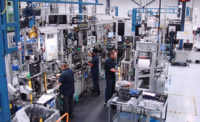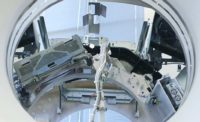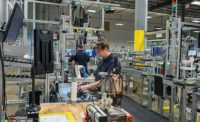In the last half century, the GE Gas Power plant in Greenville, SC, has experienced the same kind of dizzying roller coaster ride as the city where it’s located. Founded some 200 years ago on the Reedy River, Greenville grew into a textile manufacturing hot spot and a paragon of Southern hospitality—until the 1970s, when the city’s downtown took a turn. The mills closed, hotels shuttered, and the clattering trams carrying riders on shopping errands and to business lunches fell silent.
Then, two decades ago, civic and business leaders started pulling together—and began turning things around. They knocked down a four-lane highway built over Greenville’s iconic falls on the Reedy, surrounded the river with a handsome park, and restored much of the downtown’s faded glamour.
But not everyone had a reason to kick up their heels. In 2017, just as Vogue magazine touted the revived town’s burgeoning food scene, engineers at the GE plant, located a short car ride from the center of town, found themselves facing their own downturn.
When the Music Stopped
GE moved to Greenville in 1969 to manufacture huge turbines that burn natural gas to generate electricity. It’s highly specialized work. These machines can weigh as much as 1 million pounds, but their precise inner parts must fit together like clockwork. By 2015, the plant grew to 1.5 million square feet—more than 26 American football fields. Capable of generating more than 420 megawatts—enough to supply 400,000 U.S. homes—GE’s latest class of turbines set a Guinness-certified record in efficiency in 2016. But when demand for new turbines dried up a year later, the factory was left holding millions worth of high-tech parts it couldn’t use.
“We could have been investing that cash in more innovation,” says Jon Boucher, an executive responsible for special projects and initiatives at GE Gas Power.
Cyclical downturns have affected markets since they existed, but GE’s pain was inflamed by another problem. Back then, it took the company more than a year and a half to make each of its record-breaking gas turbines designated as HA in GE nomenclature. Since many of the components that go into the turbines are highly specialized, and only a few suppliers in the world can make them, GE had to order its parts far in advance.
“We were issuing purchase orders for materials and components based on a customer turbine order forecast that didn’t happen,” Boucher says. “In many cases, we got caught holding components where the true demand failed to materialize in the declining market.”
Since many of the parts were made to specific customer requirements, they couldn’t be reused and ended up as obsolete inventory. “It hurt us a lot,” he says.
Waste Not
As a system of continuous improvement, lean builds on ideas conceived by American engineer and statistician W. Edwards Deming. His theory found rich soil in postwar Japan, where Toyota engineer Taiichi Ohno used it as the basis of the fabled Toyota Production System, a set of just-in-time management principles focused on boosting production efficiency, reducing waste and creating more value with fewer resources. From there, it traveled around the world as lean management, a name coined by a Massachusetts Institute of Technology team led by researcher James Womack, whose book The Machine That Changed the World became the bible of the movement.
Lean, of course, now also sits at the heart of GE’s turnaround. “As we move forward with our lean transformation, we are not looking to simply check the box,” Larry Culp, GE’s chairman and CEO, wrote in a letter to shareholders in February. “We are changing the way we run GE, business by business, every day, from the bottom up.”
The Fix-It Team
The shop floor is exactly where Boucher and his team started. Over the years, as the Greenville factory grew, GE kept adding new machines, putting them wherever there was open space. “There wasn’t a lot of thought to layout,” Boucher recalls. “We also had a situation where disused machines never left the building. They just sat in place.” As a result, managers spent time scheduling work on available machines without considering how far each part had to travel.
Looking for a way to start unlocking the jam, they noticed that one key part, called a bucket, was piling up and waiting next to machines and slowing things down more than others. “We were looking for something that we could scale, and the bucket had the highest inventory and the highest scrap rate,” says Blake Fulton, senior advanced manufacturing engineer.
The bucket is an intricate steel blade that goes into the hot section of the turbine and spins the rotor. Workers in Greenville start shaping it by machining high-tech castings that cost tens of thousands of dollars and must be ordered from a supplier. Because temperatures inside the turbine can top the melting point of the metal that the part is made from, they also have to apply specialized coatings and other complex processes. “The bucket is the heart of the turbine,” Boucher says. “It’s a critical component.”
The Model Line
With their notepads full of observations, Boucher and the Greenville leadership team moved into a nearby administrative building and took over a large, empty section of the floor. They brought in several dozen folding tables and pushed them together to build a platform for a 1:60-scale model of the huge plant complete with miniature machines 3D-printed from black plastic. Next, they took yarn to trace the bucket’s journey through the plant, pegging it on nails along the way.
The yarn unspooled madly across the factory and doubled back on itself multiple times. The team calculated that the part traveled more than 3 miles through the plant to complete the machining process, with the journey lasting 85 days. “It just looked like a large bowl of spaghetti,” Boucher recalls. “Everybody had the same look of amazement on their face. The next reaction was, we have to fix that.”
But the length and the duration of the trip weren’t the only findings. The group also discovered that machine operators had to lift each bucket—which weighs several pounds and loosely resembles a stubby propeller blade—more than 200 times before it was finished, further slowing things down. “We found our low-hanging fruit,” Fulton says. “We kind of had to use a bulldozer for the first crop.”
The A, B, C of Lean
The team started untangling the spaghetti by building a value-stream map for the bucket. “This lean management tool allows you to see where you are adding value and whether you have waste in the system,” Boucher explains. “It really gave us a picture of what to work on and what opportunities were there.”
The first thing that came to light was that the buckets moved through the plant in fits and starts, piling up at various stages of production. “We had thousands of parts in the shop for this first component,” Boucher says. “Parts used to queue at machines all over the factory.”
To get the bucket flow unclogged, the team decided to attack the clusters of machines crowding the shop floor. Using more folding tables, they built a model of a new line that removed general-purpose machines and replaced them with smaller, specialized machines. The result was that workers could no longer shift production from a broken machine to a good one. They had to fix the issue. “The purpose of the line is to expose problems,” Boucher says. “It’s a forcing function. When you have a line, the part will go from process A to B to C by design. It has no other place to go. It has to keep moving.”
Next, they determined the speed—“takt time” in lean jargon—of the new line’s flow. The term describes the amount of time it takes to complete each step. “It’s the heartbeat of the line,” Boucher says. “It’s the rhythm the line has to produce to.” If the beat slows down or stops, the operators immediately know they have a problem.
The approach can lead to a dramatic decrease in scrap and inventory. “In the past, we would run dozens, sometimes hundreds of parts and find out that, ‘Hey, this batch of parts all have the same quality problem,’” Boucher says. “Today, those situations don’t exist anymore. Every time you do something to the part, you have to verify that it’s done correctly. If one part has trouble, you have to stop the line and fix it. With the line, there’s no inventory between the process points.”
A Name In The Hat
The team spent 11 weeks moving machines outside of the plant, digging up their concrete foundations with jackhammers, and putting the new line in place. When they were done, they were able to cut the distance the bucket had to travel from 3 miles to a mere 165 feet. They also slashed the time it took to machine the bucket by 42 percent.
It was an important early victory that showed everyone at the plant the transformative power of the lean system. But the vast majority of the factory, which still didn’t have a manager after the previous leader left, kept working the old way. That’s when John Kenney stepped up.
Kenney started his GE career in Greenville as a young engineer in 2000. He put in time at GE factories in Duluth, GA, and Bangor, ME, and returned to Greenville in 2015 as a global sourcing leader. In 2019, when GE was looking for a new plant leader in Greenville, he raised his hand. “There are a lot of great people here and I felt like I could help Greenville move in the right direction,” Kenney says. “I knew Greenville could turn around and I wanted to be part of the turnaround. So I threw my name into the hat.”
Things at the plant were still rocky, and the volatility reached beyond manufacturing. People were leaving and anxiety hung in the air as the entire GE unit was still struggling to get on its feet. The first thing Kenney did after getting the top job was to keep the spotlight on lean: “I focused on stabilization and creating an environment that could embrace lean. “It was the one thing that was going well for us among all the noise.”
Seeing Different
Partnering with Boucher and his team of lean experts, Kenney started holding lean “workouts” where managers and workers could get a taste of the new approach. “I’m not a lean expert but it’s a very logical, kind of natural thing for me,” Kenney says. “It was something I could easily embrace and get my head wrapped around. The benefits were so easy to see.”
With Boucher acting as a coach, they started bringing people to the first “model” line for the bucket, showing them how lean works and what the benefits were. “Jon helps the team to think differently about how to run a shop, from eliminating waste to setting up a new line,” Kenney says. “He is a huge driving force behind making lean successful not only here, but also at other places.”
The workouts started with just a few dozen Greenville employees, but Kenney and Boucher later opened the training to visitors from other GE facilities. GE CEO Culp attended one held last spring. Sharing his “takeaways” in an email to GE employees, Culp said that “nothing beats ‘hands-on’ learning. I lost count of how many times I heard this today. Even if you’re not a manufacturing guru, an experience like this is the best way to really absorb the fundamentals of lean. It’s exhausting, but deep learning and good fun. If you experience something, you’re unlikely to forget it.”
Kenney and groups of Greenville employees also traveled to other GE businesses to experience their approach to lean. “Until you learn differently, you only know what you’ve seen,” Kenney says. “Seeing how other folks are doing things helps broaden everyone’s mind. It’s a big, big, thing.”
Boucher agrees: “A lot of people might wonder why there isn’t just a small team of people that go from plant to plant to set up lean lines or redo the shop floor,” he says. “The reason is that you need the whole culture engaged. This is about all the employees. They need to see things the same way.”
Thumbs Up
Engagement is also the reason why Greenville plant managers—known here as “support staff”—moved their desks to the shop floor. The goal is to be closer to the operators and help them out when their line stops. Operators, says Boucher, are central: “They’re the ones that know the process far better than anybody else on the shop floor.”
Nathalie Deney, an engineer in GE’s Operations Management Leadership Program who’s finishing her rotation in Greenville, is responsible for one of the lean lines. Her desk stands at the end of a line and next to a whiteboard where workers discuss issues at the beginning and end of every shift. She says the proximity to the line helps production as well as morale. “If a problem gets brought up and it isn’t addressed, people just grow apathetic or complacent,” Deney says. “But with these lean lines, when a problem’s brought up and the team’s able to see immediate responses, that’s what brings about more suggestions for improvement. It’s just a cycle that builds on itself, where the more problems you solve, the more problems are brought up and the faster we solve them.”
Matt Ferguson, a machinist working on Deney’s line, gives her the thumbs up. “Before you had to wait up to an hour before the help would even come to you, and most of the people didn’t even have an idea what the issue was,” he says. “Now you’ve got people who are involved in that; they are the ones who are feeling the pain [with us]. It’s a whole lot easier on the operators now.”
A 1,000-Mile Journey
If lean sounds like a magic bullet, it might just be. The approach helped the Greenville plant improve quality and productivity, reduce inventory, and create an engaged workforce, without sacrificing one or the other.
Kenney and his team have put 10 lines inside the plant and more are ready to go. It took 11 weeks to put the “model” line in place. Now, the team can launch a new line in just 3.5 weeks.
Not even the COVID-19 pandemic stopped Greenville’s lean transformation. The plant has remained open due to its essential work, and the team has continued leading lean action workouts, albeit virtually, to drive the transformation forward. They even used lean principles to address the pandemic locally. For example, lean’s continuous improvement mindset has helped the plant become one of the first GE manufacturing plants in the U.S. to implement temperature monitoring for every employee.
Taken together, the improvements have allowed the team to cut overall production time—or lead time—for the HA turbine from a year and a half in 2017 to less than 40 weeks, down nearly by half, including the time it takes to get parts from suppliers. Inventory levels are down by half, saving the business hundreds of millions of dollars in capital. The plant is now working to lower the number of weeks it takes from a turbine order to shipping by a further 25 percent by the end of 2020.
Pulling old machines out of the plant and breaking up inefficient clusters also freed 50,000 square feet of factory space, with another 100,000 square feet on the horizon. Plant leaders want to use this space to bring more lucrative services and repair work in-house.
But Kenney says the plant is still just starting out. He has big plans for lean, counting on it to be “the enabler” for innovation, manufacturing and services, as well as for winning in the market. “I’m not saying that every day is perfect in the manufacturing shop, but morale is much better,” he says.
Says Kenney: “When the team understands the direction, the feeling is good, the atmosphere is good and the culture is good, even if it’s a 1,000-mile journey.”










